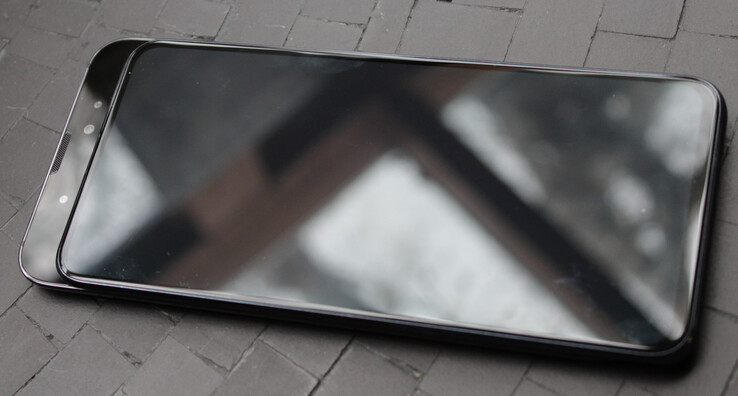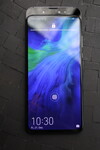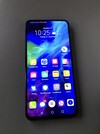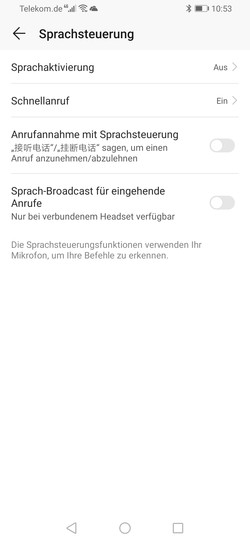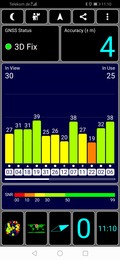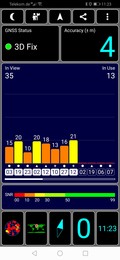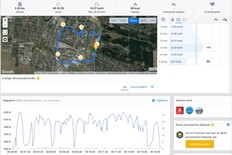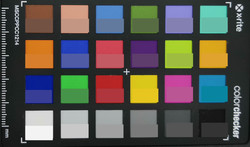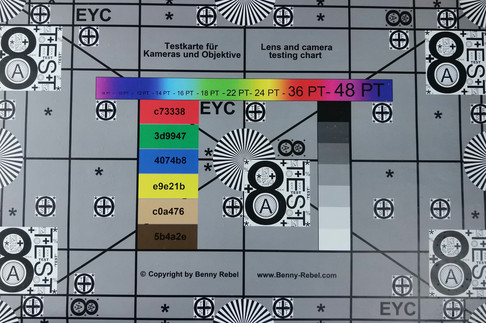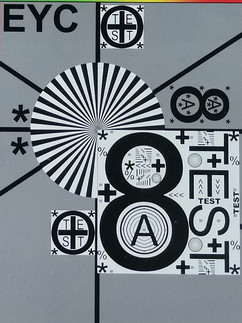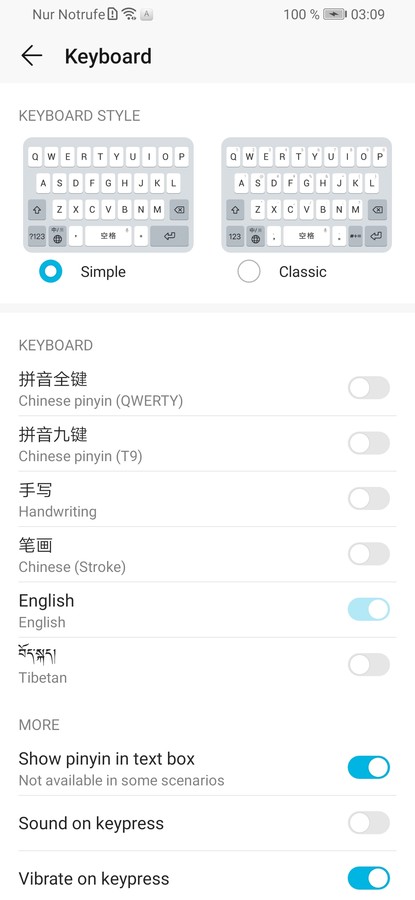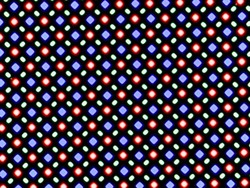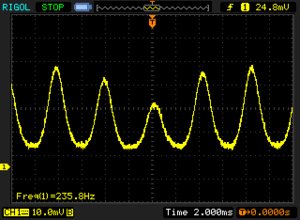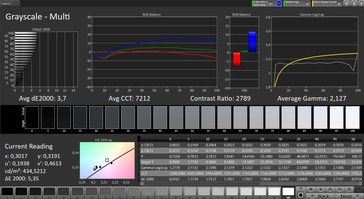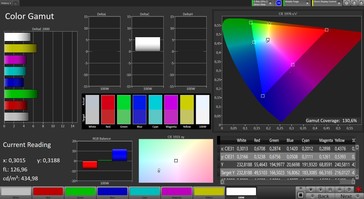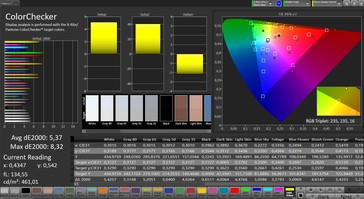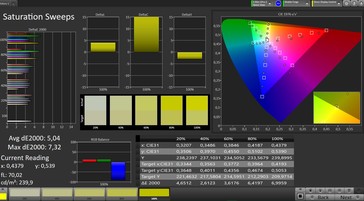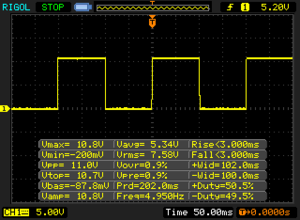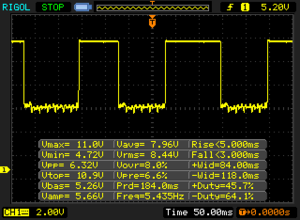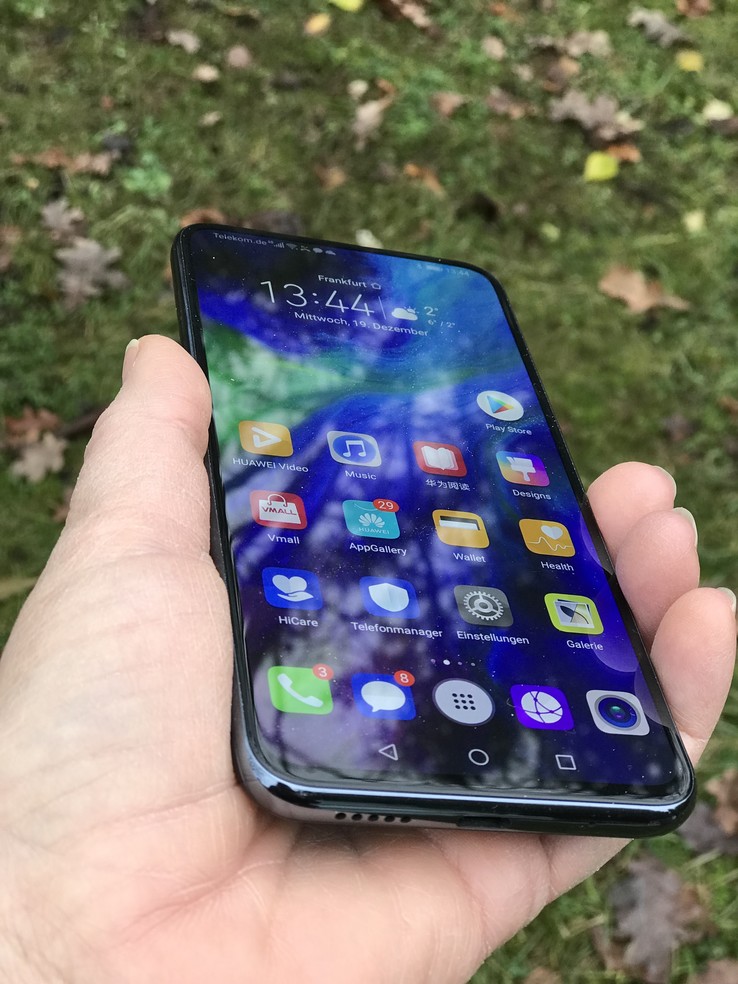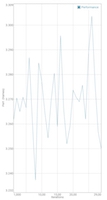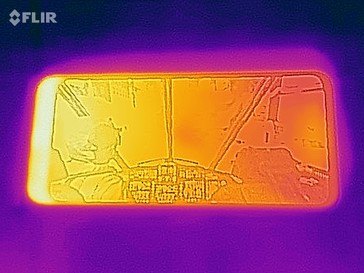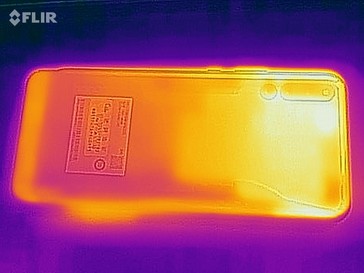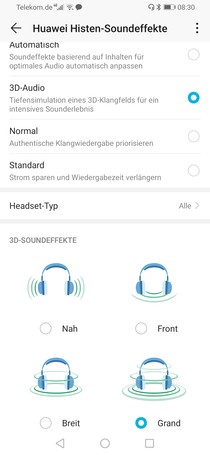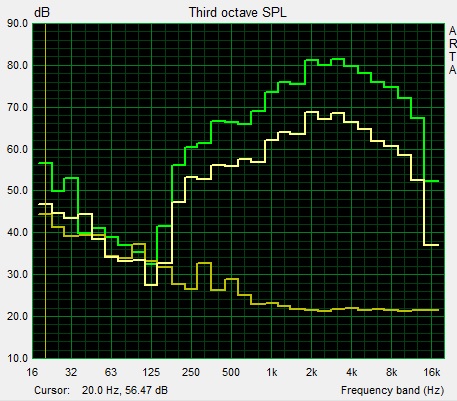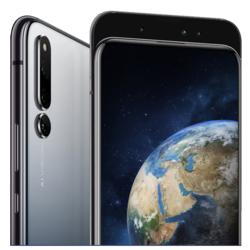Honor Magic 2 Smartphone Review
The Magic 2 is the second model in the Honor Magic series that never made it to Europe officially due to the fact that parts of the phone’s AI features would be either unavailable or would simply not work outside of China. Other characteristics include a pull-out front-facing camera, which means the Honor Magic’s display is a true full view display, triple-cameras on both sides, and high-end internal hardware.
Due to its performance prowess we have selected similarly powerful smartphones for our test group, including Apple’s iPhone XS and some Snapdragon 845-powered smartphones such as the Sony Xperia XZ2 Premium and the Xiaomi Pocophone F1. We have also included the Huawei Mate 20, since it is based on the exact same SoC as the Magic 2. Let’s see which one does best.
Case
The last model’s multi-colored glass chassis design has survived the overhaul and made it into the new model as well. On the back, a light gray-blue fades into a darker tint, which looks very classy. To our surprise the back side was not as slippery and smooth as it looked, and we were able to push out the camera by gripping the phone with four fingers and using our thumb to slide down the display.
This sliding mechanism brings about a small yet visible gap that was slightly wider on the left-hand side of our review unit than on the right-hand side. Generally speaking, the Magic 2 was very sturdy and warp resistant, but it crossed the 200 g line due to the complexity of its sliding mechanism.
Connectivity
On a more positive note, this sliding mechanism results in a true full view display worthy of that name. The bezels at the top and bottom are practically non-existent, and the phone also lacks the dreaded notch. Those who love innovations will be thrilled by the fingerprint reader embedded into the layer underneath the display, just like on the Huawei Mate 20 and the OnePlus 6T.
Acoustic performance is a notable downside, though. We expect stereo speakers in smartphones larger than 6 inches, but the Magic 2 only features a single mono speaker. It is quite possible that Honor had to sacrifice the second speaker in order to make room for the sliding mechanism. Another current trend is the omission of the 3.5-mm headphone jack, and while Honor has joined that party it does fortunately still include an adapter. The downside of this is of course that the phone cannot be charged while the adapter is in use.
Our review unit was equipped with 8 GB of RAM and 128 GB of storage, and it featured the exact same very powerful Kirin 980 SoC as the Huawei Mate 20/Mate 20 Pro. The SIM tray can take a second nano SIM but no microSD card.
Software
As expected, the Magic 2 comes with Android 9 preinstalled, and to our delight Google’s security patches were up-to-date as well (as of 12/01/2018).
A difference between the Magic 2 and every other smartphone made and sold by Huawei or Honor is the user interface. Instead of the usual EMUI skin the Magic 2 comes with the so-called Magic UI. At first glance it looks identical to EMUI since several of the AI-supported features as well as the AI-driven digital assistant named YoYo are not available to users outside of China.
Another downside of importing an Android smartphone directly from China is the fact that Google’s Play Store is missing entirely. There is an app store called Huawei App Gallery, however, it is only usable for those who know how to read Chinese. Fortunately, the menus and notifications are mostly translated and only rarely did we encounter Chinese writing. One of those examples can be seen on the right - in this particular case, answering an incoming call was only possible by saying “jie ting dian hua”. Fortunately, we were able to uninstall all of the apps with Chinese names completely.
Communication and GPS
Honor did not yet officially specify the supported UMTS and LTE bands. However, in the past Huawei’s smartphones have usually been blessed with support for a very wide range of frequencies. Accordingly, we have had no trouble using the Magic 2 in both the German T-Mobile as well as the German O2 networks. However, if you need to be absolutely sure you may want to consider asking the merchant in question.
| Networking | |
| iperf3 transmit AX12 | |
| Huawei Mate 20 | |
| Sony Xperia XZ2 Premium | |
| Xiaomi Poco F1 | |
| Honor Magic 2 | |
| Apple iPhone XS | |
| iperf3 receive AX12 | |
| Sony Xperia XZ2 Premium | |
| Xiaomi Poco F1 | |
| Apple iPhone XS | |
| Honor Magic 2 | |
| Huawei Mate 20 | |
Outdoors, GPS lock was obtained after just a few seconds, and the Magic 2’s accuracy was very decent. Indoors, it took a bit longer but we were able to obtain GPS lock even with fewer satellites available.
We test every GPS module on a quick bicycle tour around the block where we compare it to a professional Garmin Edge 520 sat-nav unit. The latter is usually very accurate; however, on the day we ran our tests it showed some inaccuracies around a wooded area. Since the Magic 2 showed the same discrepancies we are going to ignore these. Unfortunately, Honor’s smartphone was inaccurate in more than just this one spot.
In the residential area the Honor’s recorded track was very close to the Garmin’s, and total track length was almost identical as well. In other words: The Honor Magic 2 is a very capable sat-nav.
Telephony and Call Quality
The telephony app features background wallpaper by default and thus looks nicer than on other phones. Its features include automatic recording and live translation, although these two are mutually exclusive and the latter is deemed experimental. In our tests, we had trouble connecting to the server.
Call quality is decent for both conversation partners. We noticed a slight and occasional whiz on speakerphone.
Cameras
Honor says that a triple-camera setup cannot necessarily do more than a dual-camera system, but it can do the things that a dual-camera system is so famous and renowned for much better. Most importantly, this includes multi-dimensional spacial detection in order to improve Bokeh in portrait mode. Unlike the Mate 20, the Magic 2 is still equipped with a monochrome sensor. At 24 MP its resolution is higher than the other two sensors’, which makes for very fine contrast in particularly bright and dark areas of the photo. The other two lenses, a standard and a 17-mm ultra-wide-angle, feature 16 MP sensors, respectively.
In addition, a neural processing unit improves photos with an artificial image stabilization feature in low-light scenarios, and it adjusts color temperature accordingly. In the photo below the AI noticed the need for portrait mode and applied an automatic mask to the edges of the doll. According to Honor, the software is capable of detecting over 60 different categories of objects and can improve the photos accordingly.
The 16 MP front-facing camera features a total of three lenses as well. The so-called theatre mode was capable of detecting the main photo motif and separating it from the background automatically, resulting in differential lighting for back- and foreground: The foreground is lit up while the background is kept very dark.
Depth information is also used for improving face detection. Unfortunately, face detection requires sliding the display down in order to expose the cameras. While this can be easily achieved one-handed it is much more complicated and time-consuming than simply using the in-screen fingerprint reader.
When comparing the daylight photos to those of the Magic 2’s competitors we noticed some minor shortcomings. When zoomed-in, the photos seemed somewhat blurry and often underexposed and too dark. Subjectively speaking, however, the photos looked superb due to the high-contrast ratio achieved thanks to the contrast information from the monochrome sensor. HDR photos also looked impressive, and the photos got better and better with decreasing light. In poor light, photos remained well exposed and crisp, and the only smartphone even better was Apple’s iPhone XS.
When looking at the ColorChecker Passport photo we noticed an almost perfect match for warm colors and a very close match for all other colors. You can see the reference color at the top of each square. The test chart below is ideal for exposing autofocus insufficiencies and blurriness around the edges. In this case, we found no evidence thereof whatsoever.
Accessories and Warranty
Included in the box was a Chinese 40 W fast-charging power supply, a USB-C cable, and a USB-C to 3.5-mm audio adapter.
Honor designed a special case for the Magic 2, which may or may not be included depending on where you purchase the phone. If it is not, you can purchase it directly from Honor’s or Huawei’s Chinese web shop. Keep in mind that warranty claims for imports can be quite tricky. Please see our Guarantees, Return policies and Warranties article for country-specific information.
Input Devices and Handling
It takes quite a while to register a fingerprint with the new fingerprint reader located underneath the display but once it is registered unlocking the phone is surprisingly fast. Thus, those who consider having to slide the display open every time to unlock the phone via face detection overly complicated will find a viable alternative in the fingerprint reader.
By default, European versions of Honor’s smartphones come with the SwiftKey keyboard preinstalled. Since our review unit was a Chinese model it was missing, and instead we found a keyboard app called HiKeyboard that did not fully support the German keyboard layout. Thus, we decided to retroactively install Google’s Gboard keyboard app from the also retroactively installed Play Store. Google’s keyboard is an immensely popular choice with lots of customization options including haptic feedback, and the Honor Magic 2 was very usable thanks to it. The touchscreen was very snappy and responsive up to its edges.
Display
At 6.39 inches the Magic 2’s cinematic 19.5:9 display with a native resolution of 2340x1080 is quite big. It also turned out to be very bright: 594 nits is as bright for an OLED display as the Mate 20’s 782 nits is for an IPS display.
Unfortunately, we noticed PWM flickering at a comparatively low frequency of just 235 Hz, which could lead to headaches and eye strain for some users.
| |||||||||||||||||||||||||
Brightness Distribution: 85 %
Center on Battery: 594 cd/m²
Contrast: ∞:1 (Black: 0 cd/m²)
ΔE ColorChecker Calman: 5.37 | ∀{0.5-29.43 Ø4.78}
ΔE Greyscale Calman: 3.7 | ∀{0.09-98 Ø5}
130.6% sRGB (Calman 2D)
Gamma: 2.127
CCT: 7212 K
| Honor Magic 2 AMOLED, 2340x1080, 6.4" | Huawei Mate 20 TFT-LCD (IPS), 2244x1080, 6.5" | Apple iPhone XS OLED, 2436x1125, 5.8" | Sony Xperia XZ2 Premium LCD-IPS, 3840x2160, 5.8" | Xiaomi Poco F1 IPS, 2246x1080, 6.2" | |
|---|---|---|---|---|---|
| Screen | 33% | 39% | 14% | 1% | |
| Brightness middle (cd/m²) | 594 | 782 32% | 639 8% | 477 -20% | 489 -18% |
| Brightness (cd/m²) | 539 | 784 45% | 637 18% | 453 -16% | 486 -10% |
| Brightness Distribution (%) | 85 | 94 11% | 94 11% | 86 1% | 93 9% |
| Black Level * (cd/m²) | 0.36 | 0.33 | 0.34 | ||
| Colorchecker dE 2000 * | 5.37 | 2.3 57% | 1 81% | 2.1 61% | 3.8 29% |
| Colorchecker dE 2000 max. * | 8.32 | 7 16% | 2.2 74% | 8.2 1% | 7.1 15% |
| Greyscale dE 2000 * | 3.7 | 2.4 35% | 2.2 41% | 1.6 57% | 4.4 -19% |
| Gamma | 2.127 103% | 2.22 99% | 1.9 116% | 2.28 96% | 2.22 99% |
| CCT | 7212 90% | 6839 95% | 6364 102% | 6425 101% | 7213 90% |
| Contrast (:1) | 2172 | 1445 | 1438 |
* ... smaller is better
Screen Flickering / PWM (Pulse-Width Modulation)
| Screen flickering / PWM detected | 235.8 Hz | ||
The display backlight flickers at 235.8 Hz (worst case, e.g., utilizing PWM) . The frequency of 235.8 Hz is relatively low, so sensitive users will likely notice flickering and experience eyestrain at the stated brightness setting and below. In comparison: 53 % of all tested devices do not use PWM to dim the display. If PWM was detected, an average of 8101 (minimum: 5 - maximum: 343500) Hz was measured. | |||
Color accuracy is determined with support of a spectrophotometer in combination with the CalMAN software. Most colors are oversaturated in standard mode, particularly blues resulting in a slight blue tint. Since manual color temperature adjustment is supported this can be easily alleviated. Color-space coverage (sRGB) was superb, and the Magic 2 manages to cover sRGB completely, and then some.
Display Response Times
| ↔ Response Time Black to White | ||
|---|---|---|
| 6 ms ... rise ↗ and fall ↘ combined | ↗ 3 ms rise | |
| ↘ 3 ms fall | ||
| The screen shows very fast response rates in our tests and should be very well suited for fast-paced gaming. In comparison, all tested devices range from 0.1 (minimum) to 240 (maximum) ms. » 17 % of all devices are better. This means that the measured response time is better than the average of all tested devices (20.2 ms). | ||
| ↔ Response Time 50% Grey to 80% Grey | ||
| 8 ms ... rise ↗ and fall ↘ combined | ↗ 5 ms rise | |
| ↘ 3 ms fall | ||
| The screen shows fast response rates in our tests and should be suited for gaming. In comparison, all tested devices range from 0.165 (minimum) to 636 (maximum) ms. » 19 % of all devices are better. This means that the measured response time is better than the average of all tested devices (31.6 ms). | ||
Outdoor usability is usually constricted somewhat by reflective displays, which we like to demonstrate by taking a photo in bright sunshine. Luckily for the Magic 2, the sun did not show even for a minute during our entire review period, so the best we can offer is the photo below taken on an overcast day. The display should however remain fairly usable even in bright sunlight thanks to its high brightness and its AMOLED technology.
Performance
The Honor Magic 2 is equipped with Huawei’s current high-end Kirin 980 SoC combined with an ARM Mali-G76 GPU and 8 GB of RAM. Our high hopes in the Magic 2’s prowess were however disappointed, and the Magic 2 performed worse than most of its competitors. Only the Xiaomi Pocophone F1 performed similarly in some benchmarks. In 3DMark, the Magic 2 returned the lowest score of the entire test group most of the time.
The biggest surprise was the discrepancy between the Magic 2 and the Mate 20, which features the exact same SoC yet only half the RAM. Is Honor’s Magic UI really that detrimental to performance? If so this would be a very poor bodement for Honor’s AI ambitions.
| PCMark for Android | |
| Work performance score (sort by value) | |
| Honor Magic 2 | |
| Huawei Mate 20 | |
| Sony Xperia XZ2 Premium | |
| Xiaomi Poco F1 | |
| Average HiSilicon Kirin 980 (9728 - 13531, n=10) | |
| Work 2.0 performance score (sort by value) | |
| Honor Magic 2 | |
| Huawei Mate 20 | |
| Sony Xperia XZ2 Premium | |
| Xiaomi Poco F1 | |
| Average HiSilicon Kirin 980 (7567 - 9326, n=10) | |
| GFXBench 3.1 | |
| on screen Manhattan ES 3.1 Onscreen (sort by value) | |
| Honor Magic 2 | |
| Huawei Mate 20 | |
| Apple iPhone XS | |
| Sony Xperia XZ2 Premium | |
| Xiaomi Poco F1 | |
| Average HiSilicon Kirin 980 (24 - 54, n=10) | |
| Average of class Smartphone (11 - 166, n=157, last 2 years) | |
| 1920x1080 Manhattan ES 3.1 Offscreen (sort by value) | |
| Honor Magic 2 | |
| Huawei Mate 20 | |
| Apple iPhone XS | |
| Sony Xperia XZ2 Premium | |
| Xiaomi Poco F1 | |
| Average HiSilicon Kirin 980 (25 - 56, n=10) | |
| Average of class Smartphone (8.4 - 413, n=156, last 2 years) | |
| AnTuTu v7 - Total Score (sort by value) | |
| Honor Magic 2 | |
| Huawei Mate 20 | |
| Apple iPhone XS | |
| Sony Xperia XZ2 Premium | |
| Xiaomi Poco F1 | |
| Average HiSilicon Kirin 980 (268359 - 322616, n=10) | |
| AnTuTu v6 - Total Score (sort by value) | |
| Honor Magic 2 | |
| Huawei Mate 20 | |
| Sony Xperia XZ2 Premium | |
| Xiaomi Poco F1 | |
| Average HiSilicon Kirin 980 (245662 - 254229, n=9) | |
Web-browsing performance was not as bad, and the Magic 2 managed to outperform at least its two Qualcomm competitors in four of the five tests performed. As usual, Apple’s iPhone and its perfectly optimized Safari browser play in a different league.
| JetStream 1.1 - Total Score | |
| Apple iPhone XS (Safari Mobile 12.0) | |
| Huawei Mate 20 (Chrome 70.0.3538.80) | |
| Average HiSilicon Kirin 980 (93.2 - 109.9, n=9) | |
| Honor Magic 2 (Huawei Browser 9.0.1.331) | |
| Xiaomi Poco F1 (Chrome 68) | |
| Sony Xperia XZ2 Premium (Chrome 68) | |
| Octane V2 - Total Score | |
| Average of class Smartphone (2228 - 121337, n=197, last 2 years) | |
| Apple iPhone XS (Safari Mobile 12.0) | |
| Huawei Mate 20 (Chrome 70.0.3538.80) | |
| Average HiSilicon Kirin 980 (20618 - 23285, n=10) | |
| Honor Magic 2 (Huawei Browser 9.0.1.331) | |
| Xiaomi Poco F1 (Chrome 68) | |
| Sony Xperia XZ2 Premium (Chrome 68) | |
| Mozilla Kraken 1.1 - Total | |
| Sony Xperia XZ2 Premium (Chrome 68) | |
| Xiaomi Poco F1 (Chrome 68) | |
| Average HiSilicon Kirin 980 (1948 - 3098, n=10) | |
| Honor Magic 2 (Huawei Browser 9.0.1.331) | |
| Huawei Mate 20 (Chrome 70.0.3538.80) | |
| Average of class Smartphone (257 - 28190, n=154, last 2 years) | |
| Apple iPhone XS (Safari Mobile 12.0) | |
| WebXPRT 3 - Overall | |
| Average of class Smartphone (38 - 380, n=31, last 2 years) | |
| Apple iPhone XS (Safari Mobile 12.0) | |
| Huawei Mate 20 (Chrome 70.0.3538.80) | |
| Average HiSilicon Kirin 980 (86 - 124, n=10) | |
| Honor Magic 2 | |
| Sony Xperia XZ2 Premium (Chrome 68) | |
| WebXPRT 2015 - Overall | |
| Apple iPhone XS (Safari Mobile 12.0) | |
| Huawei Mate 20 (Chrome 70.0.3538.80) | |
| Average HiSilicon Kirin 980 (228 - 334, n=5) | |
| Honor Magic 2 (Huawei Browser 9.0.1.331) | |
| Xiaomi Poco F1 (Chrome 68) | |
| Sony Xperia XZ2 Premium (Chrome 68) | |
* ... smaller is better
Neither Honor nor Huawei tend to forgo the microSD slot on their devices; however, in this case Honor had to sacrifice storage expansion to the sliding mechanism design. To make amends, Honor also offers a model with 256 GB of internal storage, and our review unit’s 128 GB was quite decent as well. As a bonus, they also turned out to be pretty fast.
| Honor Magic 2 | Huawei Mate 20 | Sony Xperia XZ2 Premium | Xiaomi Poco F1 | Average 128 GB UFS 2.1 Flash | Average of class Smartphone | |
|---|---|---|---|---|---|---|
| AndroBench 3-5 | -7% | -31% | -40% | 1% | 297% | |
| Random Read 4KB (MB/s) | 143 | 157.9 10% | 136 -5% | 101 -29% | 154 ? 8% | 296 ? 107% |
| Random Write 4KB (MB/s) | 250 | 158.1 -37% | 21.75 -91% | 17.81 -93% | 130.4 ? -48% | 339 ? 36% |
| Sequential Write 256KB (MB/s) | 185 | 196.7 6% | 171 -8% | 155.6 -16% | 296 ? 60% | 1852 ? 901% |
| Sequential Read 256KB (MB/s) | 908 | 840 -7% | 749 -18% | 705 -22% | 761 ? -16% | 2228 ? 145% |
Gaming
Whether or not it makes sense to play Fortnite on a small smartphone screen is up for debate, however the Honor’s big high-contrast screen is most likely better than average for this scenario. Tapping and swiping were instantly recognized, but it was impossible to locate enemies by sound alone due to the device’s single speaker. A headset is thus inevitable.
Emissions
Temperature
(+) The maximum temperature on the upper side is 37.3 °C / 99 F, compared to the average of 35.2 °C / 95 F, ranging from 21.9 to 247 °C for the class Smartphone.
(+) The bottom heats up to a maximum of 39.4 °C / 103 F, compared to the average of 34 °C / 93 F
(+) In idle usage, the average temperature for the upper side is 28.2 °C / 83 F, compared to the device average of 32.9 °C / 91 F.
Speakers
The Honor Magic 2’s single speaker was loud enough even for video playback at less than maximum volume. At 89.7 dB(A) it was louder than the average smartphone. Very low bass frequencies were present, however at a frequency range that is inaudible to the human ear. Like on all other smartphones Huawei’s Histen Sound effects can only be enabled with a connected headset.
Honor Magic 2 audio analysis
(+) | speakers can play relatively loud (89.7 dB)
Bass 100 - 315 Hz
(-) | nearly no bass - on average 83.3% lower than median
(+) | bass is linear (0% delta to prev. frequency)
Mids 400 - 2000 Hz
(-) | nearly no mids - on average 83.3% lower than median
(+) | mids are linear (0% delta to prev. frequency)
Highs 2 - 16 kHz
(-) | nearly no highs - on average 83.3% lower than median
(+) | highs are linear (0% delta to prev. frequency)
Overall 100 - 16.000 Hz
(-) | overall sound is not linear (127.8% difference to median)
Compared to same class
» 98% of all tested devices in this class were better, 2% similar, 0% worse
» The best had a delta of 11%, average was 35%, worst was 134%
Compared to all devices tested
» 99% of all tested devices were better, 1% similar, 0% worse
» The best had a delta of 4%, average was 24%, worst was 134%
Huawei Mate 20 audio analysis
(±) | speaker loudness is average but good (78.4 dB)
Bass 100 - 315 Hz
(-) | nearly no bass - on average 18.1% lower than median
(±) | linearity of bass is average (12.5% delta to prev. frequency)
Mids 400 - 2000 Hz
(+) | balanced mids - only 4.5% away from median
(+) | mids are linear (4.8% delta to prev. frequency)
Highs 2 - 16 kHz
(±) | higher highs - on average 7.5% higher than median
(+) | highs are linear (6.2% delta to prev. frequency)
Overall 100 - 16.000 Hz
(±) | linearity of overall sound is average (23.2% difference to median)
Compared to same class
» 52% of all tested devices in this class were better, 7% similar, 41% worse
» The best had a delta of 11%, average was 35%, worst was 134%
Compared to all devices tested
» 69% of all tested devices were better, 5% similar, 26% worse
» The best had a delta of 4%, average was 24%, worst was 134%
Apple iPhone XS audio analysis
(+) | speakers can play relatively loud (87.3 dB)
Bass 100 - 315 Hz
(-) | nearly no bass - on average 17.9% lower than median
(±) | linearity of bass is average (10.3% delta to prev. frequency)
Mids 400 - 2000 Hz
(±) | higher mids - on average 5.6% higher than median
(+) | mids are linear (5.5% delta to prev. frequency)
Highs 2 - 16 kHz
(±) | higher highs - on average 8.7% higher than median
(+) | highs are linear (3.7% delta to prev. frequency)
Overall 100 - 16.000 Hz
(±) | linearity of overall sound is average (19.7% difference to median)
Compared to same class
» 30% of all tested devices in this class were better, 8% similar, 62% worse
» The best had a delta of 11%, average was 35%, worst was 134%
Compared to all devices tested
» 49% of all tested devices were better, 7% similar, 44% worse
» The best had a delta of 4%, average was 24%, worst was 134%
Battery Life
Power Consumption
This is where the magic happens. The highly anticipated 40 W power supply was able to charge the Magic 2’s 3,500 mAh battery from near empty to 50% in just 18 minutes, and to 100% in just slightly over an hour (1:10 h).
Power consumption itself was less than magical, though. When idle and in low load scenarios the Magic 2 was the most efficient smartphone in our test group. This quickly changed under load, but the device remained inconspicuous throughout the test.
We should also mention that Honor’s Super Safe Charging Technology has been certified by the TÜV Rheinland, a German Technical Inspection Association that provides inspection and product certification services.
| Off / Standby | |
| Idle | |
| Load |
|
Key:
min: | |
| Honor Magic 2 3400 mAh | Huawei Mate 20 4000 mAh | Apple iPhone XS 2658 mAh | Sony Xperia XZ2 Premium 3540 mAh | Xiaomi Poco F1 4000 mAh | Average HiSilicon Kirin 980 | Average of class Smartphone | |
|---|---|---|---|---|---|---|---|
| Power Consumption | -41% | -4% | -37% | -26% | -34% | -31% | |
| Idle Minimum * (Watt) | 0.6 | 0.69 -15% | 0.95 -58% | 0.67 -12% | 0.65 -8% | 0.802 ? -34% | 0.842 ? -40% |
| Idle Average * (Watt) | 0.9 | 2.28 -153% | 1.34 -49% | 2.5 -178% | 1.97 -119% | 2.07 ? -130% | 1.439 ? -60% |
| Idle Maximum * (Watt) | 1.9 | 2.52 -33% | 1.48 22% | 2.51 -32% | 2.01 -6% | 2.38 ? -25% | 1.624 ? 15% |
| Load Average * (Watt) | 6.3 | 5.21 17% | 4 37% | 4.3 32% | 4.29 32% | 4.87 ? 23% | 7.03 ? -12% |
| Load Maximum * (Watt) | 7.05 | 8.49 -20% | 5.13 27% | 6.87 3% | 9.05 -28% | 7.46 ? -6% | 11.3 ? -60% |
* ... smaller is better
Battery Life
As with power consumption, battery life was largely inconspicuous as well, and the Magic 2 lasted for a decent amount of time. In direct comparison with its competitors it outperformed Sony's Xperia XZ2 Premium and Apple's iPhone XS in our Wi-Fi test, during which it lasted for almost 13 hours before it ran out of power. The Mate 20 and Xiaomi's Pocophone F1 lasted significantly longer, though.
| Honor Magic 2 3400 mAh | Huawei Mate 20 4000 mAh | Apple iPhone XS 2658 mAh | Sony Xperia XZ2 Premium 3540 mAh | Xiaomi Poco F1 4000 mAh | |
|---|---|---|---|---|---|
| Battery runtime | |||||
| WiFi v1.3 (h) | 12.9 | 14.8 15% | 9.5 -26% | 9.1 -29% | 13.5 5% |
Pros
Cons
Verdict
No doubt, Honor’s Magic 2 is a very special smartphone. Its true full view display is going to please anybody who prefers a bezel-less display but dreads the existence of a notch despite the fact that these design abominations are getting smaller and smaller (see OnePlus’ recent attempts). In addition, the Magic 2 also features an amazing triple-camera system offering great photo capabilities to amateurs and professionals alike.
As long as the phone is not officially exported you will have to import it directly from China via established import channels. Prices start at around $730, and thus significantly above Huawei’s Mate 20.
In direct comparison with the Huawei Mate 20 the Magic 2 gets the short end of the stick.
But even if the price was lower the Mate 20 would still be the better choice over the Magic 2. The latter’s performance is significantly worse, and so is battery life. If you like the idea of a slider design you may also want to take a look at the Xiaomi Mi Mix 3.
Honor Magic 2
- 12/23/2018 v6 (old)
Inge Schwabe




